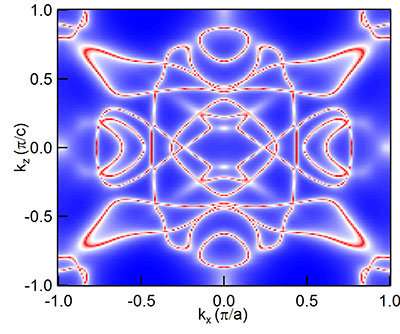Old rules apply in explaining extremely large magnetoresistance

Physicists at the U.S. Department of Energy's Ames Laboratory compared similar materials and returned to a long-established rule of electron movement in their quest to explain the phenomenon of extremely large magnetoresistance (XMR), in which the application of a magnetic field to a material results in a remarkably large change in electrical resistance. It is a useful property, which could be used in the development of computers with increased processor speeds and data storage.
Researchers in condensed matter physics at Ames Laboratory had recently discovered an extremely large magnetoresistance and a Dirac-node-arc feature in PtSn4. In this work, the researchers found another material, PdSn4, showing extremely large magnetoresistance but a gapped out Dirac-node-arc feature. In comparing these similar compounds, they ruled out Dirac-node-arc feature and electron-hole compensation as the mechanism to explain extremely large magnetoresistance.
They did find, however, that both materials' behaviors adhered to something called Kohler's Rule.
"There's this old empirical statement that if you make a metal cleaner and cleaner and cleaner, it results in larger and larger magnetoresistance," said Paul Canfield, a senior scientist at Ames Laboratory and a Distinguished Professor and the Robert Allen Wright Professor of Physics and Astronomy at Iowa State University. "Our results were an extreme example of what has been appreciated in metals physics for decades, but is now being observed at 100 or 1000 times greater extremes than we've seen before."
The comparative study serves to point the way to the conditions necessary to achieve extreme magnetoresistance.
"As a process of elimination, this work becomes a guide for future research," said Na Hyun Jo, a graduate assistant and co-author of the published research "Kohler's Rule explains the data, but it doesn't tell us why the magnetoresistance is so huge. But now we know that it is not because of Dirac node arcs, and not because of near compensation."
The research is further discussed in the paper, "Extremely large magnetoresistance and Kohler's rule in PdSn4: A complete study of thermodynamic, transport, and band-structure properties," published in Physical Review B.
More information: Na Hyun Jo et al. Extremely large magnetoresistance and Kohler's rule in PdSn4 : A complete study of thermodynamic, transport, and band-structure properties, Physical Review B (2017). DOI: 10.1103/PhysRevB.96.165145
Journal information: Physical Review B
Provided by Ames Laboratory




















